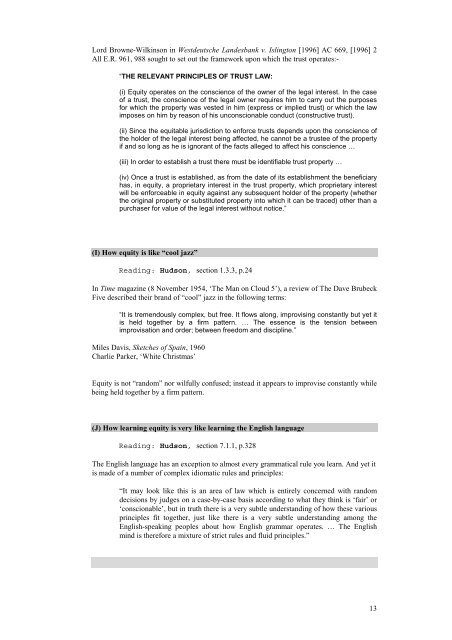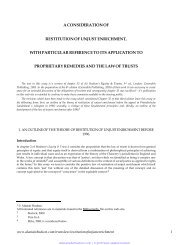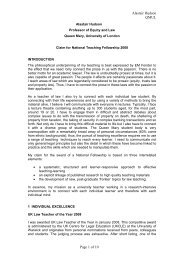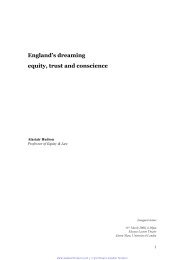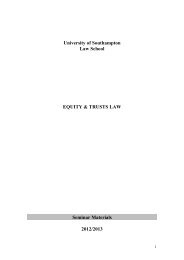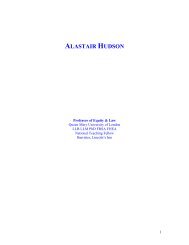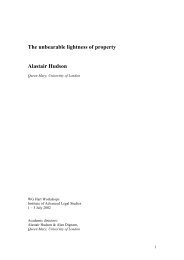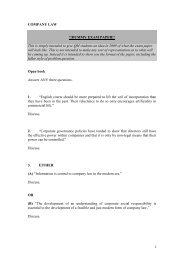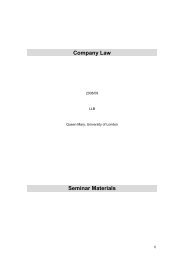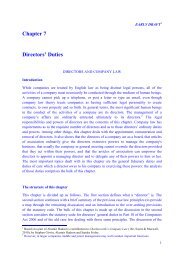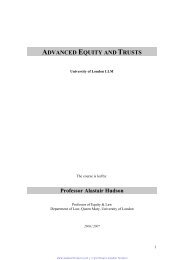Soton Equity and Trusts - alastairhudson.com
Soton Equity and Trusts - alastairhudson.com
Soton Equity and Trusts - alastairhudson.com
Create successful ePaper yourself
Turn your PDF publications into a flip-book with our unique Google optimized e-Paper software.
Lord Browne-Wilkinson in Westdeutsche L<strong>and</strong>esbank v. Islington [1996] AC 669, [1996] 2<br />
All E.R. 961, 988 sought to set out the framework upon which the trust operates:-<br />
“THE RELEVANT PRINCIPLES OF TRUST LAW:<br />
(i) <strong>Equity</strong> operates on the conscience of the owner of the legal interest. In the case<br />
of a trust, the conscience of the legal owner requires him to carry out the purposes<br />
for which the property was vested in him (express or implied trust) or which the law<br />
imposes on him by reason of his unconscionable conduct (constructive trust).<br />
(ii) Since the equitable jurisdiction to enforce trusts depends upon the conscience of<br />
the holder of the legal interest being affected, he cannot be a trustee of the property<br />
if <strong>and</strong> so long as he is ignorant of the facts alleged to affect his conscience …<br />
(iii) In order to establish a trust there must be identifiable trust property …<br />
(iv) Once a trust is established, as from the date of its establishment the beneficiary<br />
has, in equity, a proprietary interest in the trust property, which proprietary interest<br />
will be enforceable in equity against any subsequent holder of the property (whether<br />
the original property or substituted property into which it can be traced) other than a<br />
purchaser for value of the legal interest without notice.”<br />
(I) How equity is like “cool jazz”<br />
Reading: Hudson, section 1.3.3, p.24<br />
In Time magazine (8 November 1954, ‘The Man on Cloud 5’), a review of The Dave Brubeck<br />
Five described their br<strong>and</strong> of “cool” jazz in the following terms:<br />
“It is tremendously <strong>com</strong>plex, but free. It flows along, improvising constantly but yet it<br />
is held together by a firm pattern. … The essence is the tension between<br />
improvisation <strong>and</strong> order; between freedom <strong>and</strong> discipline.”<br />
Miles Davis, Sketches of Spain, 1960<br />
Charlie Parker, ‘White Christmas’<br />
<strong>Equity</strong> is not “r<strong>and</strong>om” nor wilfully confused; instead it appears to improvise constantly while<br />
being held together by a firm pattern.<br />
(J) How learning equity is very like learning the English language<br />
Reading: Hudson, section 7.1.1, p.328<br />
The English language has an exception to almost every grammatical rule you learn. And yet it<br />
is made of a number of <strong>com</strong>plex idiomatic rules <strong>and</strong> principles:<br />
“It may look like this is an area of law which is entirely concerned with r<strong>and</strong>om<br />
decisions by judges on a case-by-case basis according to what they think is ‘fair’ or<br />
‘conscionable’, but in truth there is a very subtle underst<strong>and</strong>ing of how these various<br />
principles fit together, just like there is a very subtle underst<strong>and</strong>ing among the<br />
English-speaking peoples about how English grammar operates. … The English<br />
mind is therefore a mixture of strict rules <strong>and</strong> fluid principles.”<br />
13


